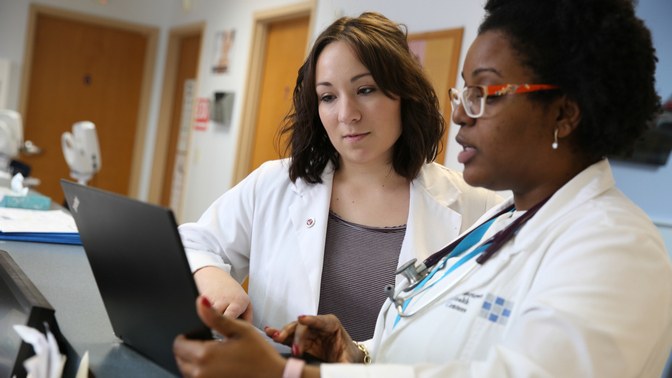
Albany College of Pharmacy and Health Sciences (ACPHS) operates two not-for-profit community pharmacies in medically underserved areas of New York's Capital Region. The first pharmacy - College Hometown Pharmacy - opened in 2016 in the Hometown Health Centers clinic in Schenectady, NY. The second pharmacy, College Parkside Pharmacy, opened in 2017 in the South End of Albany and relocated to the Whitney M. Young, Jr. Health Center in July 2019.
Each pharmacy offers the dual benefit of (1) providing a distinctive and innovative experience for ACPHS students and (2) improving access to pharmacy and health care services for members of the local community.
Meeting an Educational Need
The pharmacies allow student pharmacists to develop and refine their advanced practice skills. As full-service pharmacies, they include point-of-care screening services coupled with associated disease state counseling.
Under the supervision of a licensed pharmacist, students have opportunities to expand their patient counseling skills in areas that could include:
- Medicare Part D Plan Finder
- Blood Pressure Screening
- Disease Management and Prevention
- Medication Therapy Management
- Self Care
- Immunization/Vaccines
- Wellness Counseling
In addition to the clinical skills needed to be successful pharmacists, students have opportunities to learn the essential business skills required to successfully manage a pharmacy. The ACPHS pharmacies provide hands-on experience in revenue analysis, inventory turnover analysis, break-even analysis, and pharmacy cash-flow analysis.
Through their experiences in the pharmacies, students are be better prepared to “think like entrepreneurs,” proactively seeking out opportunities not only for operational efficiencies and growth but for creative health care business models.
Meeting a Community Need
The unfortunate truth is that the nation’s lower income communities do not attract as many retailers and providers of services as more affluent areas. Pharmacy is no exception. Medical and public health services also lag in these areas.
A study in the November 2014 issue of Health Affairs found that from 2000-2012 the number of pharmacies in predominantly Hispanic and black communities of Chicago declined by 17% and 11% respectively. Over that same period, the number of pharmacies in Chicago’s white communities increased by 30%.
According to the study’s authors, the exodus of pharmacies from underserved areas has led to the creation of “pharmacy deserts.”
In a recent report, the National Center for Health Statistics noted that 8.4% of primary care physicians would not accept new patients. The acceptance of Medicaid patients is even more severe with 35% of physicians not taking new Medicaid patients. Lower-income areas with predominantly Medicaid populations are clearly not getting the primary care services they need.
Meeting Future Needs
In addition to dispensing medications and providing related services, the College partners with local health and social service providers to jointly offer an expanded range of clinical services.
The ability to partner with a social worker or a nurse practitioner, for example, helps prepare students to serve as part of a healthcare team, one of the core tenets of a patient-centric approach to care. It also helps ensure patients have convenient access to multiple levels of health care. It will also
Adjacent to our Albany location is the ACPHS "Collaboratory." This community health resource includes space whereby students will be able to host educational forums about certain health topics or disease states, thereby expanding the learning experience to include a component of public health.
The ACPHS student-operated pharmacies will serve as prototypes for health care in disadvantaged areas of the Capitol Region. They will avoid the expansion of pharmacy deserts by allowing for improved access to prescription medications and preventive health care services for medically underserved areas.
Over time, we envision the pharmacies serving as prototypes for how to effectively provide health care in disadvantaged areas.

